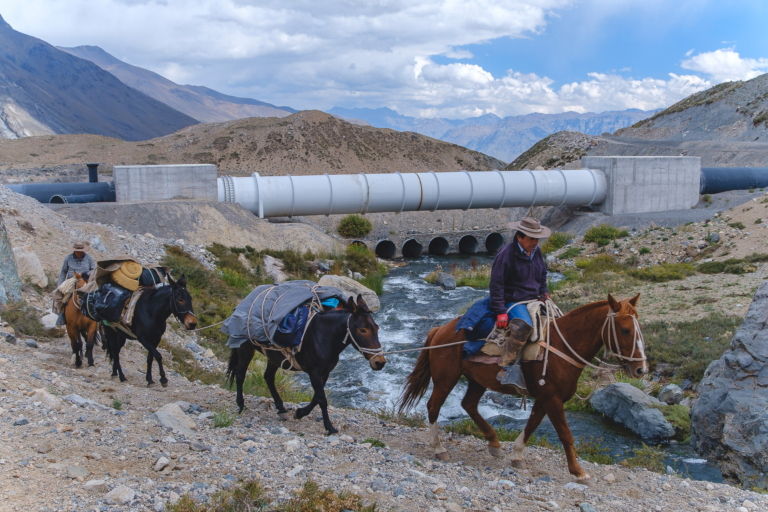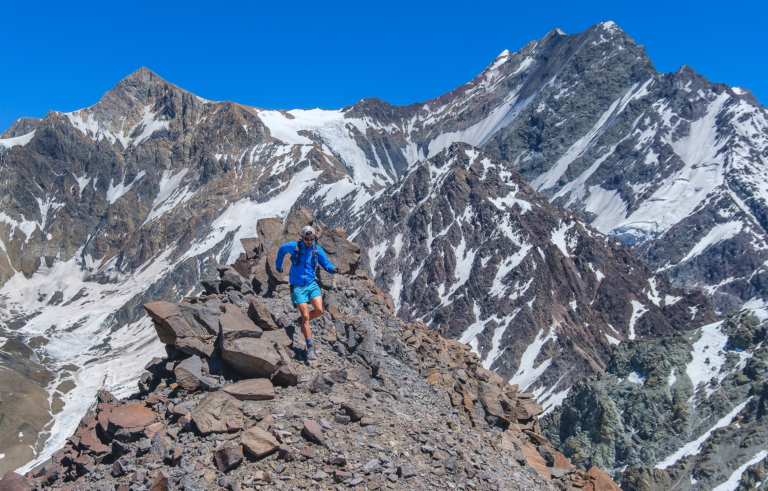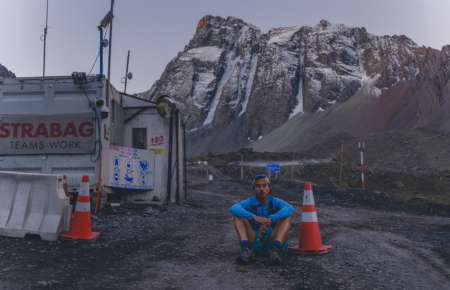For the Land We Inhabit
The communities of Cajón del Maipo, in Chile, are seeing their environment be threatened by an unnecessary hydroelectric project.
All photos by Rodrigo Manns
Every time I return home, I look into the mountains, feel the breeze coming down from the upper valley and look into the river thinking about how much longer this place will remain as we know it, for how much longer I’ll see this river running. I’d like the answer to be, for a long time, but with every day that statement feels more uncertain.
I’ve seen this valley change significantly in such a short period of time. It is almost as if the valley is actively resisting the ambition and greed of people, the compounded impacts of the many extractive activities that have historically taken pieces from this ecosystem, turning them into money and profits for businesses and large corporations. Add in the impacts of the climate crisis and the intense drought we’re experiencing in this part of the continent, and we remain unsure of how much this valley can take. It is clear that the Maipo Valley is struggling.
The Maipo Valley’s proximity to the most populated city in the country, Santiago, has historically designated it as an extraction zone, the supplier of natural resources. Mining, hydropower plants and aggregate extractions are just some of the activities concentrated in the top part of the watershed. “Extract, extract and extract,” has been the logic and mantra of the Chilean economy for a long time, and the scars this valley bears are a perfect representation of its impacts.
Out of all the industries that jeopardize the integrity of this valley, there’s one that can give it the final blow, Alto Maipo. Alto Maipo is a mega hydropower plant run by the US-based company AES Andes (formerly known as AES Gener) and the engineering Austrian company STRABAG. The project’s purpose is to capture the water of the three main watersheds that feed into the Maipo River and funnel those waters through a series of tunnels drilled under the mountains to produce energy. Despite facing intense community opposition over the last 10 years of construction, the Alto Maipo project is finally nearing completion. There’s no real consumer demand for this energy right now in Chile. In fact, the electric system is overstocked. This potential energy project is mainly to power the anticipated needs of future mining projects in the area, which will lead to even more negative environmental impacts on this region. Alto Maipo represents just the tip of the iceberg for future extractive projects in this area of Chile.
A little bit of context here. The Maipo Valley is located in the mountains, right next to the city of Santiago, which is the capital and the most populated city in Chile. Cajón del Maipo, as we call it, plays an important ecological role in the entire region. The whole watershed makes life possible for millions of people, supplying drinking water to the city of Santiago and providing clean air to the region and water for the crops of the valley. This water is stored in the hundreds of glaciers and concentrated in the main aquifer, alpine lakes, streams and creeks located in the mountains of this valley.
The human population, as well as the resilient and diverse flora and fauna of this place, depend directly on the river’s life, and right now this ecosystem is very unbalanced. Plain and simple, Alto Maipo is a mega hydroelectric project about to be launched during one of the most intense megadroughts this region has experienced on record. It will irreparably harm the fragile ecosystem in which we live in. To take the water out of this basin, in the midst of climate change and an intense, decades-long drought, sounds to me like ecocide. It is a clear example of a lack of social and environmental justice. The land and people of the Maipo Valley cannot and should not pay such high environmental costs for having all these industries installed in our lands, only to serve the interests and line the pockets of large cities and corporations in faraway places.

There is a generations-long tradition of horseback riders in Cajón del Maipo. Muleteers have seen the impacts of the Alto Maipo project in these once pristine landscapes firsthand. Laguna Encañado area , Cajón del Maipo, Chile.
This relationship with the land doesn’t represent what our generation and the majority of the population in Chile wants. This is not how we want to see this place develop, and we as locals of this valley believe this place has much more to offer, now and in the future. We dream beyond extraction.
For most people born in this region, Cajón del Maipo is most likely to be the place where you first experience the great outdoors. It’s the hotbed of recreation for more than 7 million people who live in the central area of the country. Beyond residents of the region, it is also a beautiful place for millions of visitors and tourists. Back when I was a kid, my first outdoor experiences were in the Cajón del Maipo. Here live the first mountains I climbed. My past and present are connected; the first camping experiences I had are rooted in this place where I now live.
But over time, the function of this locality has changed, and there’s an evolution of the identity of this place. Despite the fact that everybody who lives in this region depends on the ecological integrity of this area, there’s a small population that lives in the highest section of the watershed close to the mountains, and they are even more vulnerable to the direct impacts of these foreign-backed extractive projects. Cajón del Maipo is home to a community that shapes this locality and makes it a special place.
This place is home for those who were born here and have very strong and well-defined traditions living in the countryside, rural areas lower in the valley and inhabit the mountainsides. They live simply. Their incomes depend directly on the use of land and grass fields to feed their animals. They are witnesses and victims of the lack of water in the mountains, and their lifestyle is impacted by this. They have been one of the main groups of people most directly affected by the drought and the impacts of large industries.
This valley is also where the dreamers live, the ones that ran away from the city to reconnect with nature, those who wanted to live in a quiet place and have a different lifestyle. They are also the ones who wanted to start their own business, and the ones going a step ahead pushing to protect nature and their environment. We have a lot to learn from them.
Cajón del Maipo is a cluster of many small community groups. The incredible access to the outdoors and the landscapes surrounded by mountains, glaciers and rivers makes this place a world-class destination for tourism. This is an opportunity that many have seen and taken, starting their own business to develop the ecotourism industry in the area. There’s a large number of entrepreneurial individuals and families who have developed a local economy in the valley associated with outdoor recreation and tourism. This is the first true economic development in the valley, and these people also rely on the balance of the ecosystem and its integrity to sustain their jobs, businesses and way of life.
This place is also charged with natural energy, one that is a source of inspiration for many artists, writers, art creators, musicians and people who find creativity by staying tuned into a different frequency. They are usually called the “hippies,” but I think we have so much to learn from them and their connection with the natural elements, from which our modern societies have disconnected us.
Access to the mountains and rivers attracts many outdoor enthusiasts and athletes too, who practice their sports and activities in the valley and want to experience a connection with nature in wild places. Unfortunately, these pursuits have also been impacted by the increasing prohibitions to backcountry access now largely controlled by the various industries and corporations in the area. The top of the valley in Río Colorado, the place where I live, is home to an area with 28 mountains over 5,000 meters (16,404 feet) above sea level and close to 300 glaciers. This is the biggest piece of public land available in central Chile, an area of 142,000 hectares (350,890 acres), and access is controlled by AES Andes, the same company behind the Alto Maipo project. I recently went on a 30-day mountaineering expedition to this valley after sneaking through the access. It was the only possible way to get into this incredible area.

When it comes to defending the environment, all forms of activism are worth trying. Felipe runs in Cajón del Maipo during the filming of Run to Salvar una Cuenca. Paso Marmolejo, Cajón del Maipo, Chile.
Another iconic area forbidden to people is an area with two spectacular and big alpine lakes, controlled by the drinking water supplier company Aguas Andinas, which is also associated with Alto Maipo. The access to these areas is totally prohibited for everybody who wants to visit this place. There are 33 other different issues related to access in the area. The places where we recreate and practice our sports are under a huge threat right now, and the access to them is completely controlled by these big corporations.
Conservationists, environmentalists and grassroots activists are another group of people who have been taking a huge role in advocating for the environment and protecting their home here in this valley. Thanks to their hard campaigning and efforts, we now have a few conservation areas, campaigns advocating for the environment and against the extractive projects of these large corporations, and multiple plans to link the protection of the environment with education and more local and sustainable economies. Lagunillas and Cascada de las Ánimas are two private conservation areas where people have been working hard to restore the ecosystem and preserve biodiversity. Many species of endangered plants and animals live in these areas.
There’s also a very big campaign called Queremos Parque, literally, “We want a park,” whose main goal is to protect this huge piece of public land and connect it with some other conservation areas around it to establish a biological corridor for many species. I feel lucky to have these areas right in my backyard and know them very well. I want to see them protected so future generations have the opportunity to enjoy them as I have.
This is an interconnected environment. The way of living for the communities that live in Cajón del Maipo depends directly on the health of this place. Those of us who live in the Maipo Valley rely on its integrity for activities like tourism, outdoor recreation, education and conservation, giving this place a unique identity—one that is in sharp contrast with the threats of these large extractive projects. For all these community groups, taking care of our environment is a high priority. We the people who want to see a change of direction in our country are unified in defending and protecting this place and the land. The community of Cajón del Maipo has worked hard to rebuild our relationship with the environment, which is exactly what our planet needs more of right now. We need to reimagine the future, transform our economies and move away from this nasty old guise of extraction and destruction in the name of “development.”
The next question is, where do we go from here?
The environmental issues we are facing in the Cajón del Maipo area are, in many ways, a microcosm of what is happening in so many different regions throughout Chile, where we have many rural communities under threat from the impacts of mining projects, hydropower, mineral extraction and more, which are mostly owned and invested in by foreign corporations. Based on how strategic this watershed is for the country, Alto Maipo symbolizes the crux of these issues our economy and future are facing right now. We either continue taking as much as we can at the expense of the environment or we change the rules of the game entirely. It seems to me that this decision is crucial for the future of the valley. If we as a country allow this hydropower plant to happen, then our ecosystem will suffer the consequence of our negligence as society. But we have an opportunity here to redefine the direction where things have gone in the past and stop Alto Maipo before it is too late.
We all can make some of those changes and start advocating for our environment. A large portion of the community in Cajón del Maipo has already started.
Learn more about the fight to save the Maipo River Valley and take action to save this watershed. Patagonia.com/RunTo.

